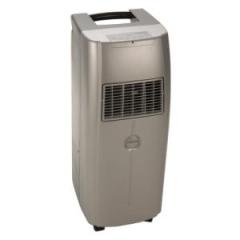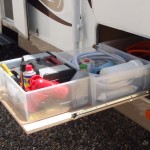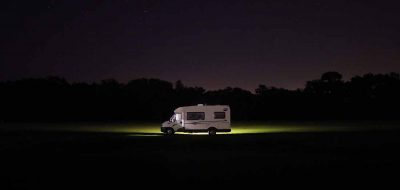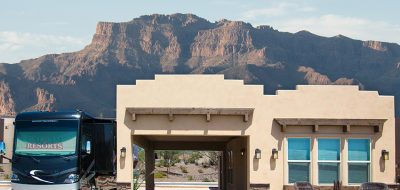Here are some Energy efficient A/C cooling and a few hints and things I’ve done in setting my 5’er up for the long hot dog days of summer. Now I may be gone during some of this time, but the 5’er will remain cooler!
The rear of my 5’er sat facing the west and the afternoon sun. What I did here is to as Reflectix to the rear windows facing the afternoon sun. Before I put this on I noticed the window itself was pretty hot and it was only in the mid 80’s! Once I put the Reflectix up it made quite a bit of difference!
Now the biggie and yep another real big time money saver! Being in the valley or anywhere where it’s over 100 like it got there some days for several days on end. I only had the one Carrier Air V that came with the 5’er. 13,500 BTU A/C was NOT enough for that kind of heat. I knew eventually I’d have to ad another A/C. I did my research as usual and went the unconventional route (as I usually do). Another RV type A/C added over the bedroom would run after cost and install around $900 to $1,0000.
After extensive research AND with great apprehension I bought a Amcor KF 9000E portable A/C at Home Depot for just at $300.

I had heard these things were noisy and didn’t work well so I figured I could take it back if I had to, but also had read raving reports too. Let me tell you this thing WORKS! It is QUIET! A 9000 BTU A/C that really pumps out the cold air and runs on only 7.9 amps and 830 watts!. Roof top A/C’s usually run around 1800 watts! The drawback is it has a 4” hose that has to be vented to the outside. Mine was done easily through one of the windows with the window kit that came with it. It vents out the hot air. Due to low energy consumption I’ll use this as the primary A/C and kick in the roof unit when needed. It takes up a very amazingly small footprint of space except for the 4” exhaust hose of 12”W x15”Dx30”H. It also serves as quite a dehumidifier and no water containers to drain! There are several models and makes to choose from for this project, i just listed mine here.
This project saved me at least $700 not to mention I paid for electric there so being it only uses 7.9 amps (830 watts) that alone saved me a lot more! So the really super hot days there of summer I’m able to keep the rig pretty darn cool and in a very energy efficient manner.
Well it heated up as predicted. My little portable A/C did not fail me at all! Below are some readings I took throughout the day mainly running only the portable Amcor 9000. I did a couple times fire up the roof top for short periods to see the difference, but for the most part that little portable job did its thing all by itself. I’m impressed. See some results…..
Time outside temp & inside temps…(Portable only running)
2:00 p.m. 93 / 79
2:30 p.m. 95 / 80
3:30 p.m. 97 / 83
3:50 p.m. 97 / 84
(turned on roof air also…both running)
4:26 p.m. 100 / 79
5:30 p.m. 100 / 78
7:30 p.m. turned roof air and off left portable on
As the evening wore on and by late evening temps inside were down to the low 70’s with the portable a/c on only. I talked to a friend and he reminded me I have a Kill O Watt meter! I plugged the Amcor into it and it average around 7.5 amps of power and around 800 watts. It used a whopping .95 KWH (just under 1 KWH)! Man, now that’s pretty energy efficient! Especially compared to the roof unit! My base line charge for electric is 12.4 cents per KWH so basically the unit costs approx. $ .12 per hour to run. If I ran it 24/7 it would cost $1.93 x 30 days = $57.90 per month. The roof top burns at least twice that.
I’m was impressed and very relieved. Here I was going to use this to augment my roof top unit and in all reality it went the other way! I only ran my roof top a/c for a couple hours the whole day and the rest of the time my Amcor did its thing and at half the energy as the roof top unit! My buddy Walter picked one up for his bedroom at home and proved to be a winner at night in his bedroom lowering his bill considerably. I did start the Amcor portable early in the morning so as not to let the rig heat up making things work harder later to get it cooled back down and that evidently paid off .
A very important note to make here is …The Amcor only draws 7.9 amps making it usable with NO problems with my Honda 2000 generator! Now I like that a lot! With some very hot temps there the test has eased my mind knowing I’ll be comfortable. On the 1st I got my first electric bill (for 2 weeks) and was interesting to see and my monthly bill was a LOT lower than the previous month. I could certainly ad some to that later in summer during the dog days of summer. How much remained to be seen. Overall this has been a great project with huge benefits! I had logged my final results in my RV Notebook software for reference during testing so I could go back and compare when I got my bill. Man was I a happy camper! My budget section of my RV Notebook was just as happy! My RV notebook has saved the day many times!






Tony Cornett
MF……. I unfortunately don’t have any pics of the window vent and it is not set up now as I’m on the coast in cool weather. The units come with a “window mounting kit” for the exhaust and it can be trimmed/cut to fit just about any window. I put mine in the forward living room slideout window. If you go look at the units you can see what the window mounting kit looks like. The Montana’s (most) are laid out similar to my Challenger so it shouldn’t be a difficult thing. There was a small gap below where the window mount went that I just “sealed’ by cutting a small piece of Styrofoam to fit and take up the gap. A little imagination and about 20 minutes of work 😉 worked like a charm…
Tony
aka Firedude
M Feeney
Mr. Cornett: Any chance you could include a photo of how you vented your portable A/C? We have to decide how to cool the front living area of our 37′ Montana 5’er located in FL. This area faces the hot morning sun and can’t be adequately cooled by the rear bedroom A/C alone. So far we have thought it would be by adding a second A/C in the living area but the cost has been estimated at between $1200 and $1500 (non-ducted vs ducted). After reading your posting, we are wondering about using a portable A/C instead. However, we are trying to visualize which window we could use, how we would position the vent. (We have a Keystone Montana 3685FL). We would really appreciate any suggestions (one front area slideout window cranks out, another slides left to right, and several small/very narrow windows in that area open by sliding up and down). MF
Tony Cornett
Jim,
* Thanks for the heads up on the 12,000 BTU unit, but when I bought mine the 12K unit was considerably more at the time. I imagine they’ve come down now. Like my article/blog also says there are many to choose from and the one I got was the one I chose.;) Either way it sure paid off in comfort and expense. If I had to do it again? Sure maybe the 12K unit, absolutely, but the one I have though seems to suffice well in a 34′ 5’er.
The cost savings to me the hot months I was there helping my elderly dad was significant to say the least. It paid for itself the first 2 months in that hot hole! It also beat the expense of an additional rooftop not only in cost, but the additional expense in electricity to run the 2nd rooftop unit.
Tony
Jim Peterson
==========
I shared your article with one of my Yahoo groups and our resident solar architect had this response:
“Too bad they did not do a little better research and bought the Amcor Nano-Max 12000BTU unit, for only about 25% more, which uses the same amount of electricity, but delivers 33.3% more cooling.”
==========
Regarding power consumption:
“Let me tell you this thing WORKS! It is QUIET! A 9000 BTU A/C that really pumps out the cold air and runs on only 7.9 amps and 830 watts!”
My architect replies:
“That is exactly the same wattage as the 12000BTU unit uses.”
==========
Regarding the exhaust flex duct:
“Roof top A/C’s usually run around 1800 watts! The drawback is it has a 4” hose that has to be vented to the outside.”
My architect replies:
“I see that as an advantage, not a drawback. It is easy to vent a 4″ hose. it is hard to stick the whole end of a window unit through the wall. Plus, you can use the hose heat to warm your water, since it blows out air at about 135F. You can’t do that with a window or roof unit.”
==========
Apparently the larger unit also operates with a hand-held remote.
==========
Send reply to [email protected] if you want.
==========
Jo Spannaus
Thanks for the info on the portable cooler. We’ve been looking at them to help keep our 30′ 5er cooler. Considered replacing our roof top cooler as is 12 yrs. old but hated to spend the money. Sure glad someone else was thinking along the same lines. Thanks again, Jo & Jim Spannaus